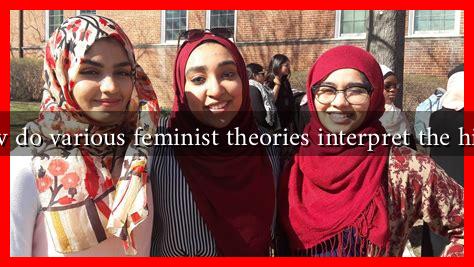-
Table of Contents
How Do Various Feminist Theories Interpret the Hijab?
The hijab, a traditional headscarf worn by many Muslim women, has become a focal point of debate within feminist discourse. The interpretations of the hijab vary significantly across different feminist theories, each offering unique perspectives on its implications for women’s rights, autonomy, and identity. This article explores how liberal, radical, intersectional, and postcolonial feminisms interpret the hijab, providing insights into the complexities surrounding this symbol of faith and culture.
Liberal Feminism: Autonomy and Choice
Liberal feminists advocate for individual rights and freedoms, emphasizing the importance of personal choice. From this perspective, the hijab can be seen as a symbol of empowerment when worn voluntarily. Key points include:
- Personal Agency: Liberal feminists argue that women should have the autonomy to choose how they express their identity, including the decision to wear the hijab.
- Legal Rights: Many liberal feminists support legal protections for women who choose to wear the hijab, viewing it as a matter of religious freedom and personal expression.
- Countering Stereotypes: By embracing the hijab, women can challenge stereotypes and assert their identity in a predominantly secular society.
For instance, in countries like France, where the hijab has been a subject of legal restrictions, liberal feminists have argued against such bans, framing them as infringements on personal liberties. They advocate for a society where women can choose to wear the hijab without facing discrimination or prejudice.
Radical Feminism: Oppression and Patriarchy
In contrast, radical feminists often view the hijab as a symbol of patriarchal oppression. They argue that the practice of wearing the hijab is rooted in a system that seeks to control women’s bodies and sexuality. Key arguments include:
- Symbol of Control: Radical feminists contend that the hijab is imposed on women by patriarchal structures, limiting their freedom and reinforcing gender inequality.
- Critique of Religious Institutions: They often critique religious institutions that mandate the hijab, viewing them as perpetuators of male dominance.
- Focus on Liberation: Radical feminists advocate for the liberation of women from all forms of oppression, including cultural practices that they perceive as harmful.
For example, in some conservative societies, women may face severe consequences for not wearing the hijab, reinforcing radical feminist views that it is a tool of oppression rather than empowerment.
Intersectional Feminism: Context and Diversity
Intersectional feminism emphasizes the importance of context and the diverse experiences of women. This perspective recognizes that the hijab cannot be understood in isolation but must be viewed through the lens of race, class, and culture. Key insights include:
- Diverse Experiences: Intersectional feminists highlight that the meaning of the hijab varies significantly among women from different backgrounds and cultures.
- Agency in Context: They argue that for some women, wearing the hijab is a form of resistance against Western imperialism and a reclaiming of cultural identity.
- Solidarity and Support: Intersectional feminists advocate for solidarity among women, recognizing that their struggles are interconnected.
For instance, the hijab can serve as a powerful symbol of identity for Muslim women in Western societies, where they may face discrimination. In this context, wearing the hijab can be an act of defiance against cultural assimilation.
Postcolonial Feminism: Decolonizing Narratives
Postcolonial feminists critique the Western-centric narratives surrounding the hijab, arguing that these perspectives often ignore the voices and experiences of Muslim women themselves. Key points include:
- Decolonizing Feminism: Postcolonial feminists seek to deconstruct the binary of oppressor and oppressed, recognizing that Muslim women have agency in their choices.
- Critique of Western Feminism: They argue that Western feminists often impose their values on Muslim women, failing to understand the complexities of their lived experiences.
- Empowerment through Choice: Postcolonial feminists emphasize that wearing the hijab can be a source of empowerment and pride for many women.
For example, many Muslim women actively participate in feminist movements while wearing the hijab, challenging the notion that they are oppressed simply because of their choice of attire.
Conclusion: A Multifaceted Symbol
The hijab is a multifaceted symbol that elicits diverse interpretations across various feminist theories. While liberal feminists celebrate it as a choice and a form of empowerment, radical feminists critique it as a tool of oppression. Intersectional feminists emphasize the importance of context and diversity, while postcolonial feminists challenge Western narratives that overlook the agency of Muslim women. Understanding these varied perspectives is crucial for fostering a more inclusive dialogue about women’s rights and identity in a globalized world.
Ultimately, the hijab serves as a reminder of the complexities surrounding women’s choices and the need for a nuanced understanding of feminism that respects individual agency while acknowledging systemic inequalities. For further reading on this topic, you can explore resources from organizations like Feminist.com and Women’s Rights Coalition.




